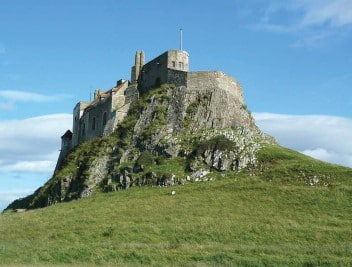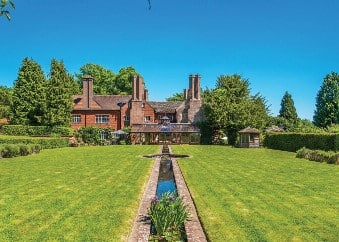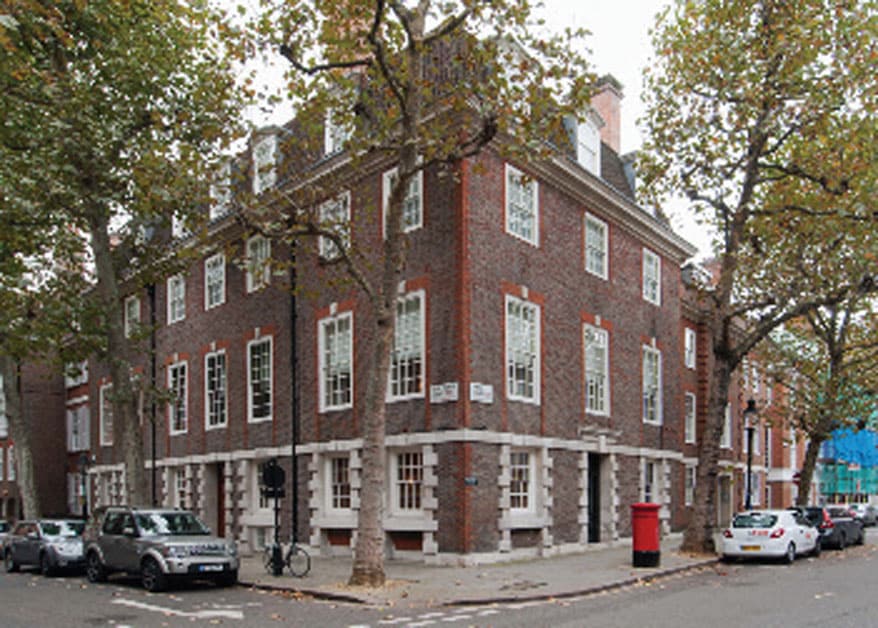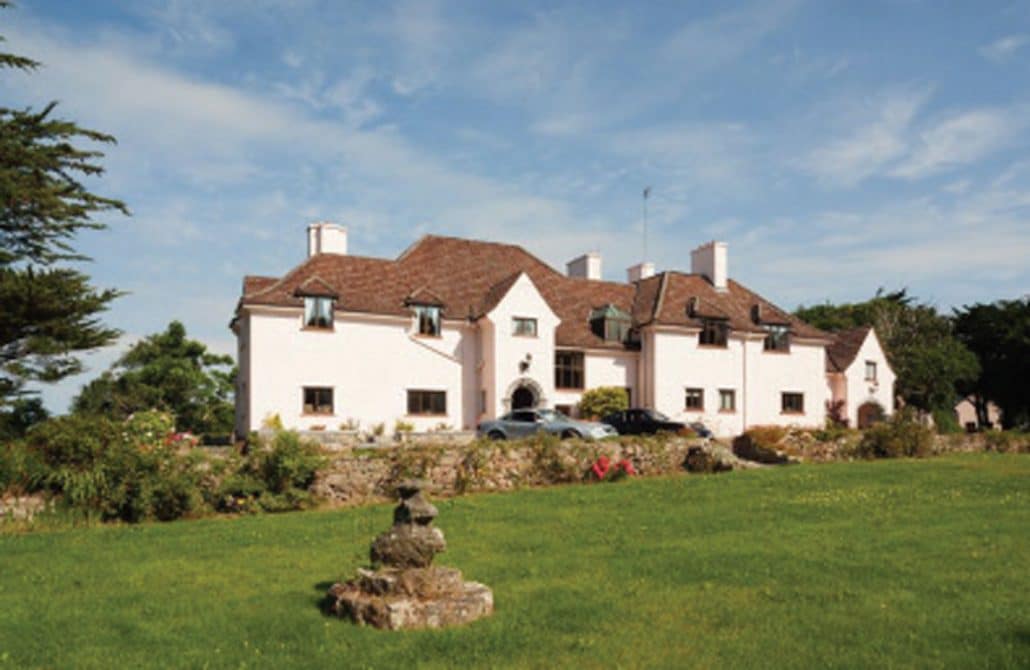Lutyens in Northumberland – a lecture given by Dr Mervyn Miller for Members of the Northumberland and Newcastle Society
by Suzanne Stanley
Lindisfarne Castle on Holy Island
At 16, Edwin Lutyens, keenly observant of building structures and materials, went briefly to South Kensington School of Art, and by the age of 20, in 1889, was already in private practice. Dr Miller related some domestic details of Lutyens’s life before focusing on Northumbrian examples of his work. The earliest, dating from 1893, was the well-crafted reredos in the early classical Church of the Holy Trinity in Berwick-upon-Tweed. One of his last was at Meldon Park, a house designed by John Dobson in a severe classical style, where Lutyens replaced his iron staircase with an imperial one in timber.
Lutyens idolised Richard Norman Shaw, designer of Cragside near Rothbury and herald of the Arts and Crafts style, which encouraged Edward Hudson, founder of Country Life magazine, to commission him to design his country houses in Berkshire.
As owner of Lindisfarne Castle on Holy Island, Hudson then asked Lutyens to redesign and add to the building. The work was completed in 1912, and ranged from external work, such as the beautifully cobbled ramp, to major structural interior work — vaulted ceilings, arches, the use of different levels linked by steps and carefully installed fireplaces and cupboards. Already it’s Lutyens’s use of materials — slate, wood, flagstones and herringbone brickwork — that stands out. By now, Gertrude Jekyll had a working relationship with Lutyens, combining her planting schemes with his structural garden designs, and it is her walled garden that stands close to the castle. Also on Holy Island is a simple cross created by Lutyens, a design he used many times, including at Hartburn in Stockton-on-Tees.
Further good examples of his gardens can be seen at Angerton Hall, also in Hartburn, and Whalton Manor near Morpeth, which demonstrate his love of playing with levels, steps, slip paving, cobble patterns, slabs and hedging. He remodelled Whalton Manor in 1908, including the gardens, which display those characteristic features alongside stone structures such as gateway columns, a pergola, a tiny gazebo and pavilion with Tuscan Doric columns. In 1924, his daughter Ursula married the 3rd Viscount Ridley and, from 1926 to 1938, he significantly redesigned the formal gardens at Blagdon Hall. Dr Miller described the lime walk there as “a remarkable example of architectural landscaping”, using millstones, slate slip paving, obelisks, the (now) enormous hostas which soften and integrate the design of walls and steps and the circular pond with its happy arrangement of circular and diamond-shaped slabs. His front garden includes a paved terrace and an 850 ft-long canal, tapered to look even longer, ending in a circular pond, known as the “sky mirror”. In 1948-49, Lutyens’s son Robert carried out alterations and restoration work on the house after a fire there in 1944.
Legh Manor, Cuckfield, West Sussex
The Corner, Thursley, Surrey
Aged only 18 but believing “they had nothing left to teach him”, Edwin Lutyens left the architecture course at South Kensington School of Art that he was attending and joined the office of Ernest George & Peto, a leading architects practice. During this period and shortly before he set up his own practice in 1889, Lutyens received a commission — one of his earliest — to extend a 17th-century cottage and shop known as The Corner, located opposite his parents’ house in his home village of Thursley, in 1888.
His client was Edmund Gray, for whom he added a wing to the back of the building. It was a small yet significant job, its style no doubt heavily influenced by George’s more compact house designs. Lutyens made further additions in 1895. This charming village house is now Grade II-listed and has five bedrooms, two bathrooms, three reception rooms, a study, garage and garden measuring approximately one-third of an acre. Available through Knight Frank. Price: £1.6m.
Some significant houses previously featured in this column remain on the market:
Mulberry House, Westminster, London
Mulberry House, 16 Smith Square, Westminster, London
Built for Reginald McKenna in the Neo-Georgian style in 1911, the house passed to Henry Mond, the ICI heir, who had the interior extensively remodelled in 1930 in the Art Deco style. The Grade II-listed accommodation includes three main reception rooms, seven bedroom suites, a gym, roof terrace and staff quarters. It is priced at £17m and available through Dexters.
The Ruckmans Estate, Okewood Hill
The Ruckmans Estate, Okewood Hill, near Dorking, Surrey
The exceptional Ruckmans Estate remains available. With a garden designed by Jekyll, this eight-bedroom Lutyens house of 1894 with a 1902 extension is the centrepiece of a 507-acre estate that includes seven cottages and two other houses, together with farm buildings. Available through Savills: Priced at £12m.
It is pleasing to report that Ferry Inn, Rosneath, Dunbartonshire (featured in the Winter 2016 Newsletter) has been sold. This cottage on the shores of Gare Loch — commissioned by HRH Princess Louise, daughter of Queen Victoria — is a wonderful example of Lutyens’s Arts and Crafts style with Art Nouveau influences.
Chinthurst Hill, Wonersh, Surrey, which recently came to the market, has already found a buyer. The nine-bedroom house of 1893 is situated among 18 acres of gardens and grounds with a swimming pool, tennis court and lodge cottage.
Mesnil Warren, Newmarket, Suffolk has a sale agreed, following a price reduction from £2.95m to £2.35m. The 1925 extension was designed by Lutyens for the Hon
George Lambton, Lord Derby’s racehorse trainer.
The following houses previously featured in the column have received price reductions:
Little Thakeham, near Pulborough, West Sussex has been reduced from £6m to £5.5m. Described by Lutyens as “the best of the bunch”, the Grade I-listed nine bedroom house stands in 15 acres and is available through Strutt & Parker.
Crooksbury, Farnham, Surrey of 1889 was Lutyens’s first country-house commission. It was later extended and remodelled by him in 1898 and again in 1914. The property for sale is the eastern wing, which is now Grade II-listed and has seven bedrooms set in 6.5 acres of garden designed by Jekyll. Its price has been reduced from £2.5m to £2.25m and it’s available through Hamptons International.
Warren Mere, Thursley, Surrey has received a significant reduction from £6.75m to £4.95m. Its original 16th-century building was extensively altered and extended by Lutyens in 1896 and again in 1909. Now Grade II-listed, it has eight bedrooms and is set in 51 acres. Available through Hamptons International.
Richard Page is marketing director of Dexters, London’s largest independent estate agent. He has advised on the sale of many Edwin Lutyens houses during his 35-year career. Do please contact him with any Lutyens-related property news at [email protected]
Disclaimer: prices and availability correct at time of going to press.





 Follow us on X
Follow us on X Follow us on Instagram
Follow us on Instagram Follow us on Facebook
Follow us on Facebook Follow us on YouTube
Follow us on YouTube

